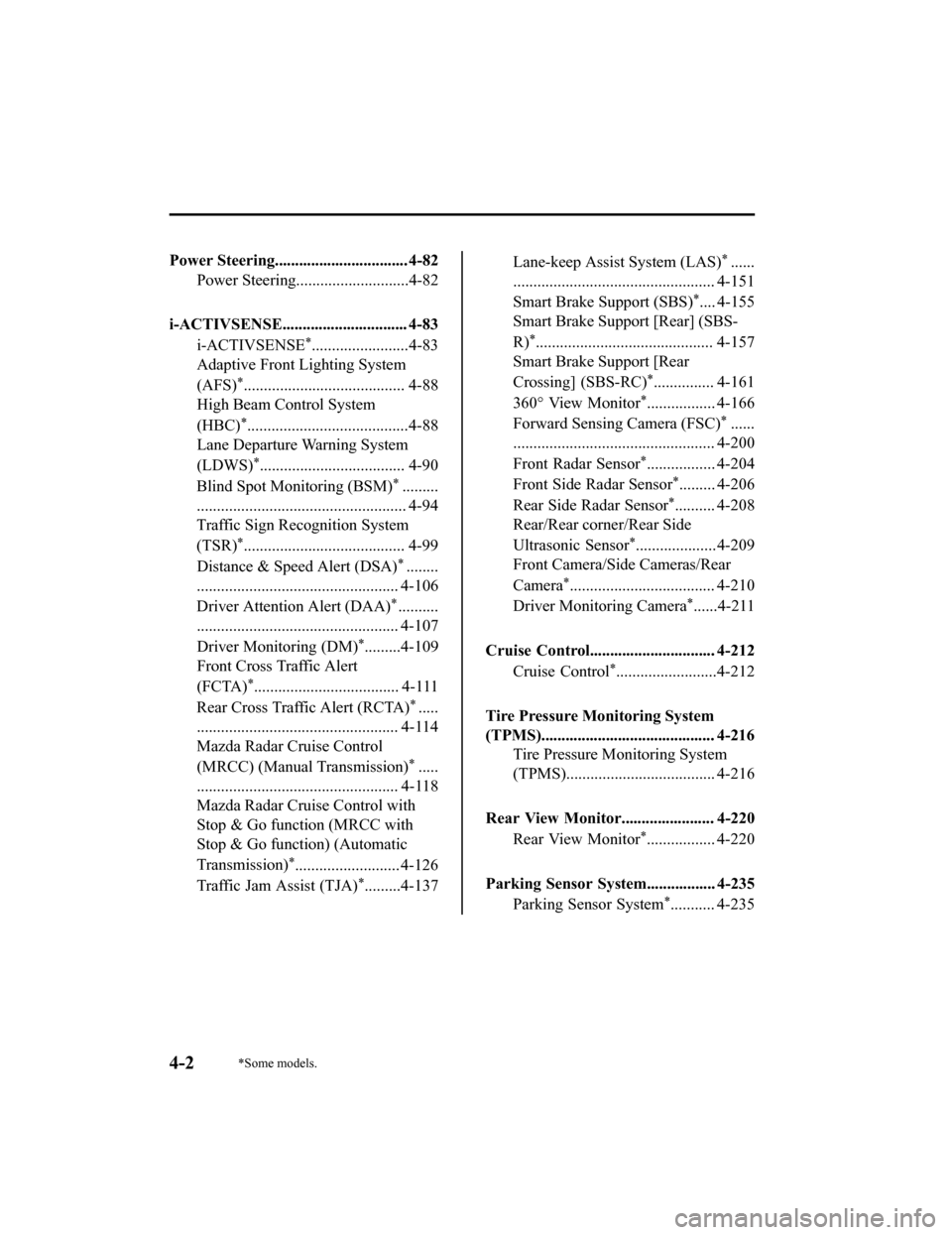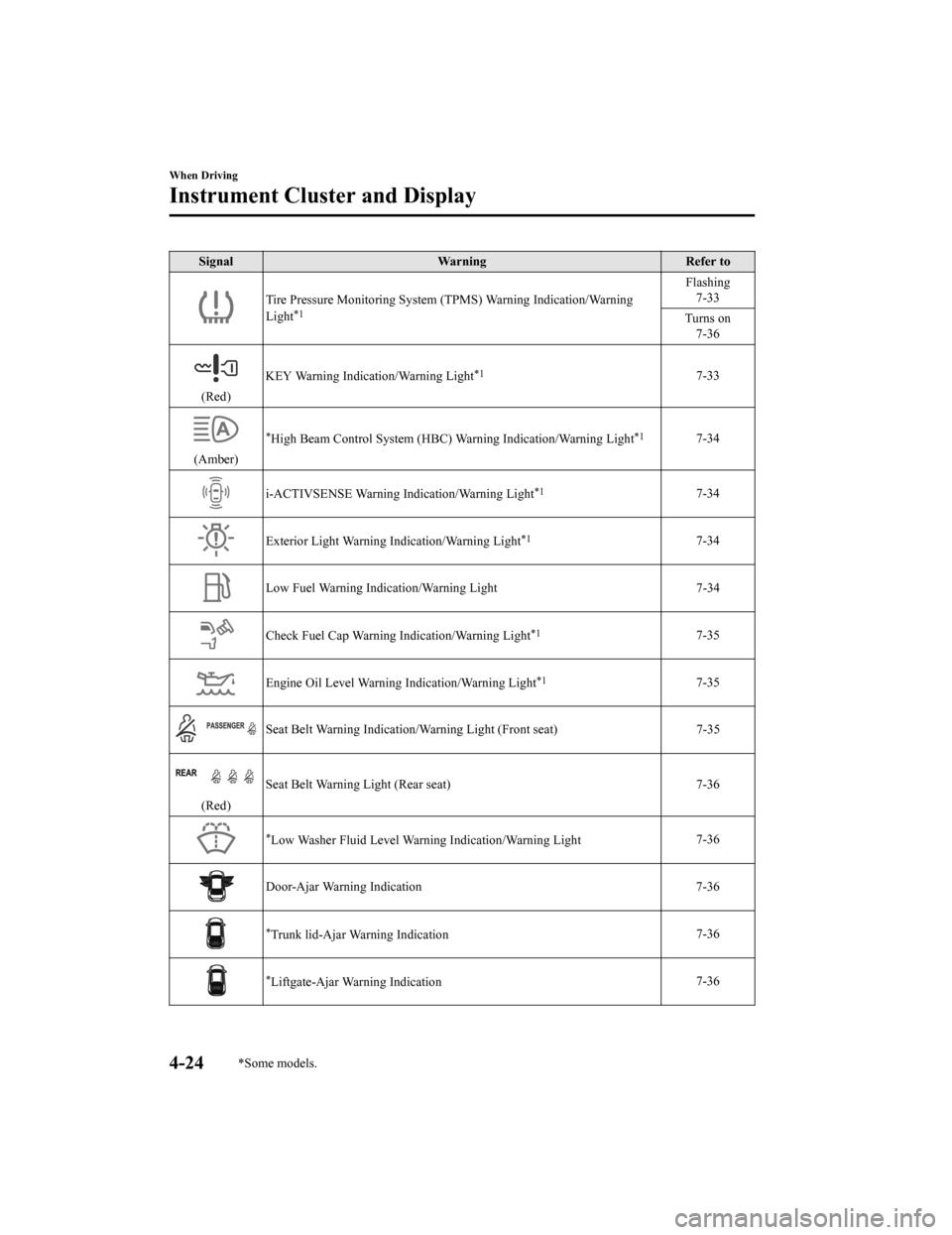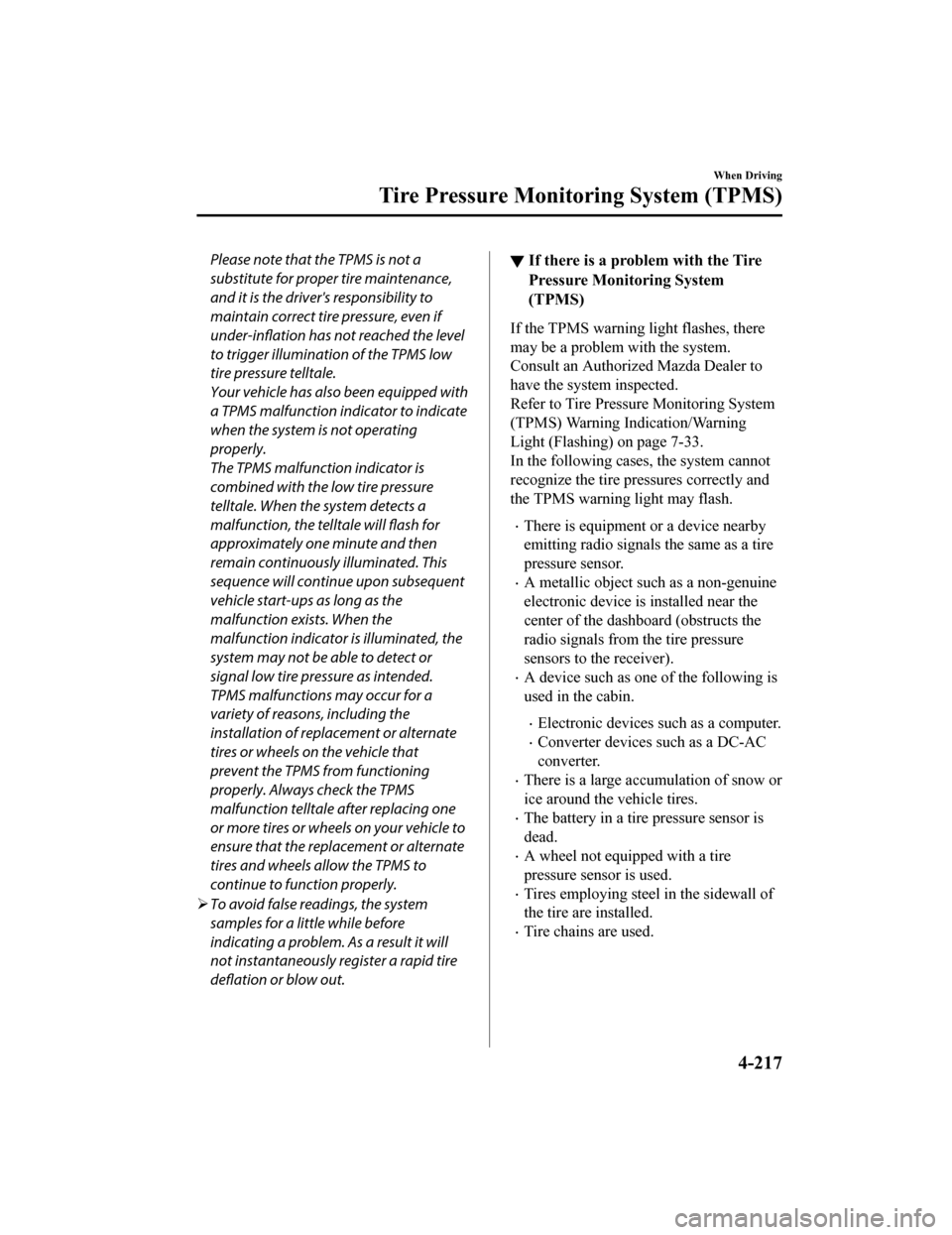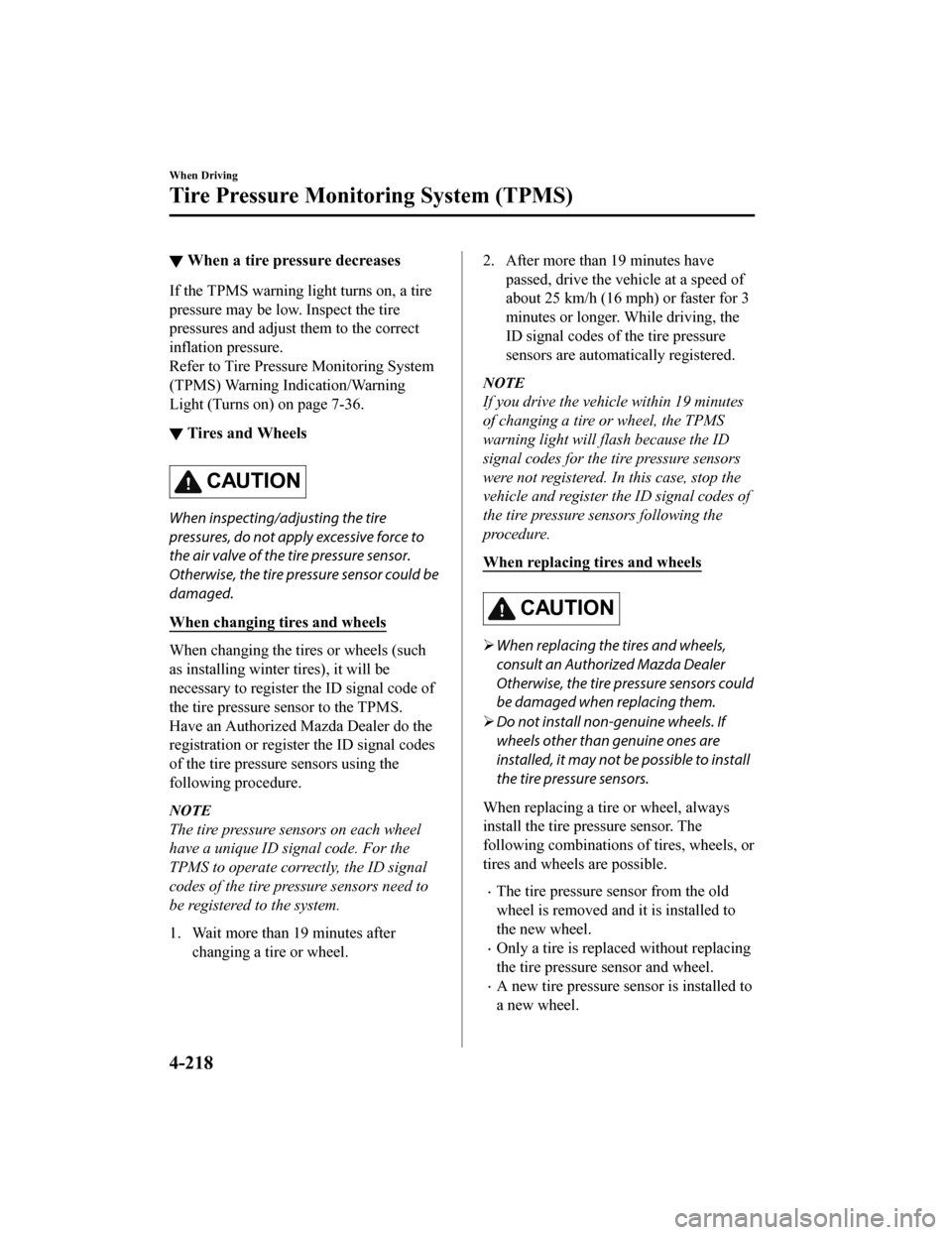TPMS MAZDA MODEL 3 HATCHBACK 2020 Owners Manual (in English)
[x] Cancel search | Manufacturer: MAZDA, Model Year: 2020, Model line: MODEL 3 HATCHBACK, Model: MAZDA MODEL 3 HATCHBACK 2020Pages: 598, PDF Size: 89.37 MB
Page 146 of 598

Power Steering................................. 4-82Power Steering............................4-82
i-ACTIVSENSE............................... 4-83 i-ACTIVSENSE
*........................4-83
Adaptive Front Lighting System
(AFS)
*........................................ 4-88
High Beam Control System
(HBC)
*........................................4-88
Lane Departure Warning System
(LDWS)
*.................................... 4-90
Blind Spot Monitoring (BSM)
*.........
.................................................... 4-94
Traffic Sign Recognition System
(TSR)
*........................................ 4-99
Distance & Speed Alert (DSA)
*........
.................................................. 4-106
Driver Attenti on Alert (DAA)
*..........
.................................................. 4-107
Driver Monitoring (DM)
*.........4-109
Front Cross Traffic Alert
(FCTA)
*.................................... 4-111
Rear Cross Traffic Alert (RCTA)
*.....
.................................................. 4-114
Mazda Radar Cruise Control
(MRCC) (Manual Transmission)
*.....
.................................................. 4-118
Mazda Radar Cruise Control with
Stop & Go function (MRCC with
Stop & Go function) (Automatic
Transmission)
*.......................... 4-126
Traffic Jam Assist (TJA)
*.........4-137
Lane-keep Assist System (LAS)*......
.................................................. 4-151
Smart Brake Support (SBS)
*.... 4-155
Smart Brake Support [Rear] (SBS-
R)
*............................................ 4-157
Smart Brake Support [Rear
Crossing] (SBS-RC)
*............... 4-161
360° View Monitor
*................. 4-166
Forward Sensing Camera (FSC)
*......
.................................................. 4-200
Front Radar Sensor
*................. 4-204
Front Side Radar Sensor
*......... 4-206
Rear Side Radar Sensor
*.......... 4-208
Rear/Rear corner/Rear Side
Ultrasonic Sensor
*....................4-209
Front Camera/Side Cameras/Rear
Camera
*.................................... 4-210
Driver Monitoring Camera
*......4-211
Cruise Control............................... 4-212 Cruise Control
*.........................4-212
Tire Pressure Monitoring System
(TPMS)........................................... 4-216 Tire Pressure Monitoring System
(TPMS)..................................... 4-216
Rear View Monitor....................... 4-220 Rear View Monitor
*................. 4-220
Parking Sensor System................. 4-235 Parking Sensor System
*........... 4-235
4-2*Some models.
Mazda3_8HZ1-EA-19G_Edition1_old 2019-5-17 13:49:03
Page 168 of 598

SignalWarning Refer to
Tire Pressure Monitoring System (TPMS) Warning Indication/Warning
Light*1
Flashing 7-33
Turns on 7-36
(Red) KEY Warning Indication/Warning Light
*17-33
(Amber)
*High Beam Control System (HBC) W
arning Indication/Warning Light*17-34
i-ACTIVSENSE Warning Indication/Warning Light*17-34
Exterior Light Warning Indication/Warning Light*17-34
Low Fuel Warning Indication/Warning Light 7-34
Check Fuel Cap Warning Indication/Warning Light*17-35
Engine Oil Level Warning Indication/Warning Light*17-35
Seat Belt Warning Indication/Warning Light (Front seat) 7-35
(Red)Seat Belt Warning Light (Rear seat) 7-36
*Low Washer Fluid Level Warning Indication/Warning Light
7-36
Door-Ajar Warning Indication
7-36
*Trunk lid-Ajar Warning Indication7-36
*Liftgate-Ajar Warning Indication7-36
When Driving
Instrument Cluster and Display
4-24*Some models.
Mazda3_8HZ1-EA-19G_Edition1_old
2019-5-17 13:49:03
Page 360 of 598

Tire Pressure MonitoringSystem (TPMS)
▼Tire Pressure Monitoring System
(TPMS)
The TPMS monitors the air pressure of
each tire and if it decreases below the
specified value, the system notifies the
driver by turning on the TPMS warning
light in the instrument cluster and
indicating a message on the
multi-information display.
For the TPMS, the air pressure data sent
from the tire pressure s
ensors installed on
each wheel via radio signal is received by
the receiver unit in t he vehicle to monitor
the tire pressures.
1. Tire pressure sensors
In addition, the current tire pressures can
be checked using the center display.
Refer to the Vehic le Status Monitor
section in the Mazda Connect Owner's
Manual.
NOTE
When the ambient temperature is low,
the tire temperatures also decrease. If
the tire temperatures decrease, the air
pressure in the tires will also decrease
which could turn on the TPMS warning
light.
Before driving, visually inspect the tires
for abnormalities. Additionally, inspect
the tire pressures monthly. A digital type
air pressure gauge is recommended for
inspecting the tire pressures.
The TPMS is not a substitute for your own
periodic inspection of the tires. Always
inspect the tires yourself periodically.
CAUTION
Each tire, includ ing the spare (if
provided), should be checked monthly
when cold and inflated to the
inflation
pressure recommended by the vehicle
manufacturer on the vehicle placard or
tire inflation pressure label. (If your
vehicle has tires of a different size than
the size indicated on the vehicle placard
or tire inflation pressure label, you should
determine the proper tire inflation
pressure for those tires.)
As an added safety feature, your vehicle
has been equipped with a tire pressure
monitoring system (TPMS) that
illuminates a low tire pressure telltale
when one or more of your tires is
significantly under-inflated. Accordingly,
when the low tire pressure telltale
illuminates, you should stop and check
your tires as soon as possible, and inflate
them to the proper pressure. Driving on a
significantly under-inflated tire causes
the tire to overheat and can lead to tire
failure. Under-inflation also reduces fuel
efficiency and tire tread life, and may
affect the vehicle's handling and
stopping ability.
When Driving
Tire Pressure Monitoring System (TPMS)
4-216
Mazda3_8HZ1-EA-19G_Edition1_old 2019-5-17 13:49:03
Page 361 of 598

Please note that the TPMS is not a
substitute for proper tire maintenance,
and it is the driver's responsibility to
maintain correct tire pressure, even if
under-inflation has not reached the level
to trigger illumination of the TPMS low
tire pressure telltale.
Your vehicle has also been equipped with
a TPMS malfunction indicator to indicate
when the system is not operating
properly.
The TPMS malfunction indicator is
combined with the low tire pressure
telltale. When the system detects a
malfunction, the telltale will flash for
approximately one minute and then
remain continuously illuminated. This
sequence will continue upon subsequent
vehicle start-ups as long as the
malfunction exists. When the
malfunction indicator is illuminated, the
system may not be able to detect or
signal low tire pressure as intended.
TPMS malfunctions may occur for a
variety of reasons, including the
installation of replacement or alternate
tires or wheels on the vehicle that
prevent the TPMS from functioning
properly. Always check the TPMS
malfunction telltale after replacing one
or more tires or wheels on your vehicle to
ensure that the replacement or alternate
tires and wheels allow the TPMS to
continue to function properly.
To avoid false readings, the system
samples for a little while before
indicating a problem. As a result it will
not instantaneously register a rapid tire
deflation or blow out.▼ If there is a problem with the Tire
Pressure Monitoring System
(TPMS)
If the TPMS warning light flashes, there
may be a problem with the system.
Consult an Authorized Mazda Dealer to
have the system inspected.
Refer to Tire Pressu
re Monitoring System
(TPMS) Warning Indication/Warning
Light (Flashing) on page 7-33.
In the following cases, the system cannot
recognize the tire pressures correctly and
the TPMS warning light may flash.
There is equipment or a device nearby
emitting radio signals the same as a tire
pressure sensor.
A metallic object such as a non-genuine
electronic device is installed near the
center of the dashboard (obstructs the
radio signals from the tire pressure
sensors to the receiver).
A device such as one of the following is
used in the cabin.
Electronic devices such as a computer.
Converter devices such as a DC-AC
converter.
There is a large accumulation of snow or
ice around the vehicle tires.
The battery in a tir e pressure sensor is
dead.
A wheel not equipped with a tire
pressure sensor is used.
Tires employing steel in the sidewall of
the tire are installed.
Tire chains are used.
When Driving
Tire Pressure Monitoring System (TPMS)
4-217
Mazda3_8HZ1-EA-19G_Edition1_old 2019-5-17 13:49:03
Page 362 of 598

▼When a tire pressure decreases
If the TPMS warning light turns on, a tire
pressure may be low. Inspect the tire
pressures and adjust them to the correct
inflation pressure.
Refer to Tire Pressure Monitoring System
(TPMS) Warning Ind
ication/Warning
Light (Turns on) on page 7-36.
▼ Tires and Wheels
CAUTION
When inspecting/adjusting the tire
pressures, do not apply excessive force to
the air valve of the tire pressure sensor.
Otherwise, the tire pressure sensor could be
damaged.
When changing tires and wheels
When changing the tires or wheels (such
as installing winter tires), it will be
necessary to register the ID signal code of
the tire pressure s
ensor to the TPMS.
Have an Authorized Mazda Dealer do the
registration or register the ID signal codes
of the tire pressure sensors using the
following procedure.
NOTE
The tire pressure sensors on each wheel
have a unique ID signal code. For the
TPMS to operate correctly, the ID signal
codes of the tire pressure sensors need to
be registered to the system.
1. Wait more than 19 minutes after
changing a tire or wheel.
2. After more than 19 minutes havepassed, drive the vehicle at a speed of
about 25 km/h (16 mph) or faster for 3
minutes or longer. While driving, the
ID signal codes of the tire pressure
sensors are automatically registered.
NOTE
If you drive the vehicle within 19 minutes
of changing a tire or wheel, the TPMS
warning light will flash because the ID
signal codes for the tire pressure sensors
were not registered. In this case, stop the
vehicle and register the ID signal codes of
the tire pressure sensors following the
procedure.
When replacing tires and wheels
CAUTION
When replacing the tires and wheels,
consult an Authorized Mazda Dealer
Otherwise, the tire pressure sensors could
be damaged when replacing them.
Do not install non-genuine wheels. If
wheels other than genuine ones are
installed, it may not be possible to install
the tire pressure sensors.
When replacing a tire or wheel, always
install the tire pressure sensor. The
following combinations of tires, wheels, or
tires and wheels are possible.
The tire pressure s ensor from the old
wheel is removed and it is installed to
the new wheel.
Only a tire is replaced without replacing
the tire pressure sensor and wheel.
A new tire pressure se nsor is installed to
a new wheel.
When Driving
Tire Pressure Monitoring System (TPMS)
4-218
Mazda3_8HZ1-EA-19G_Edition1_old 2019-5-17 13:49:03
Page 363 of 598

NOTE
When installing a new tire pressure sensor,
the ID signal code for the tire pressure
sensor needs to be registered. For details
on purchasing a tire pressure sensor and
registering the ID signal of the tire
pressure sensor, consult an Authorized
Mazda Dealer
When Driving
Tire Pressure Monitoring System (TPMS)
4-219
Mazda3_8HZ1-EA-19G_Edition1_old2019-5-17 13:49:03
Page 517 of 598

WA R N I N G
Never tamper with the air bag/
pretensioner systems and always have an
Authorized Mazda Dealer perform all
servicing and repairs:
Self-servicing or tampering with the
systems is dangerous. An air bag/
pretensioner could accidentally activate or
become disabled causing serious injury or
death.
▼Tire Pressure Monitoring System
(TPMS) Warning Indication/
Warning Light (Flashing)
If there is a problem with the TPMS or the
voltage of a tire pressu
re sensor decreases,
the TPMS warning light flashes and a
message is displayed on the
multi-information display. Have your
vehicle inspected by an Authorized Mazda
Dealer.
WA R N I N G
Do not drive the vehicle at high speeds if
the TPMS warning light turns on or flashes:
Driving the vehicle at high speeds while the
TPMS warning light is turned on or flashing
is dangerous because the brake
performance and the steering wheel
operability will be reduced. If the vehicle is
driven at high speeds or the brakes are
suddenly applied, it could lead to an
accident. Gradually apply the brakes to
lower the vehicle's speed.
Do not ignore the TPMS warning light
when it is turned on or flashing:
Continuing to drive the vehicle while
ignoring the illumination/flashing of the
TPMS warning light is dangerous because a
tire may burst which could lead to an
accident. Take appropriate measures as
soon as possible.
▼ KEY Warning Indication/Warning
Light (Red)
“Keyless Entry System Malfunction.
Have the Vehicle Ins
pected” is displayed
This message is displayed if the advanced
keyless entry & push button start system
has a problem.
Contact an Authorized Mazda Dealer.
CAUTION
If the message is indicated, or the push
button start indicator light (amber)
flashes,
the engine may not start. If the engine
cannot be started, try starting it using the
emergency operation for starting the
engine, and have the vehicle inspected at
an Authorized Mazda Dealer as soon as
possible.
Refer to Emergency Operation for Starting
the Engine on page 4-9.
“Low Key Fob Battery. Replace
Battery” is displayed
When the key battery is low, the indication
is displayed when the ignition is switched
OFF.
If Trouble Arises
Warning/Indicator Lights and Warning Sounds
7-33
Mazda3_8HZ1-EA-19G_Edition1_old 2019-5-17 13:49:03
Page 520 of 598

Action to be taken
Fasten the seat belts.
▼Seat Belt Warning Light (Rear seat)
(Red)
If the rear seat belts are not fastened while
the ignition is swit
ched ON , the driver
and the passenger are alerted by the
warning light.
The warning light oper ates even if there is
no passenger on the rear seat.
NOTE
If a rear seat belt is not fastened by a
certain period of time after the engine has
been started, the warning light turns off.
Action to be taken
Fasten the seat belts.
▼ Low Washer Fluid Level Warning
Indication/Warning Light*
This warning light i
ndicates that little
washer fluid remains.
Action to be taken
Add washer fluid (page 6-19).
▼ Door-Ajar/Trunk lid-Ajar/
Liftgate-Ajar Warning Indication/
Wa r n i n g L i g h t
The light turns on if any door/trunk lid/
liftgate is not closed securely.
Action to be taken
Close the door/trunk lid/liftgate securely.
▼Tire Pressure Monitoring System
(TPMS) Warning Indication/
Warning Light (Turns on)
If a tire pressure decreases below the
specified air pressure
, the TPMS warning
light turns on.
At the same time, a message and the tire
pressure of each tire are displayed on the
multi-information display alternately. In
addition, the tire (s) with low air pressure
is displayed in yellow.
If Trouble Arises
Warning/Indicator Lights and Warning Sounds
7-36*Some models.
Mazda3_8HZ1-EA-19G_Edition1_old 2019-5-17 13:49:03
Page 521 of 598

WA R N I N G
Do not drive the vehicle at high speeds if
the TPMS warning light turns on or flashes:
Driving the vehicle at high speeds while the
TPMS warning light is turned on or flashing
is dangerous because the brake
performance and the steering wheel
operability will be reduced. If the vehicle is
driven at high speeds or the brakes are
suddenly applied, it could lead to an
accident. Gradually apply the brakes to
lower the vehicle's speed.
Do not ignore the TPMS warning light
when it is turned on or flashing:
Continuing to drive the vehicle while
ignoring the illumination/flashing of the
TPMS warning light is dangerous because a
tire may burst which could lead to an
accident. Take appropriate measures as
soon as possible.
NOTE
While the TPMS is learning the tire
positions, such as immediately after a tire
position has been changed, the tire
pressure at the tire position prior to it
being changed is displayed until the
system completes the learning. For this
reason, the tire pressures displayed for the
tire positions may be different from the
actual tire pressures at the tire positions.
Action to be taken
Adjust the tire pressu res to the appropriate
pressures.
Refer to Tire Inflation Pressure on page
6-31.
CAUTION
Adjust the tire pressures while the tires
are cool. Because the air pressure in the
tires
fluctuates depending on the
temperature, before adjusting the tire
pressures, let the vehicle sit for an hour or
drive it only within a 1.6 km (1 mile)
distance. If the tire pressures are adjusted
while the tires are warm, the tire
pressures may decrease below the specified air pressure after cooling down
which could turn on the warning light. In
addition, because the air pressure in the
tires decreases when the ambient
temperature is low, if the ambient
temperature increases, an illuminated
TPMS warning light may turn off. Under
any circumstances, always adjust the tire
pressures while the tires are cool.
After adjusting the tire pressures, the
TPMS warning light turns off. If the TPMS
warning light does not turn off, drive the
vehicle at a speed of about 25 km (16
mph) or faster for 3 minutes or longer
and make sure the warning light turns
off.
If the TPMS warning light remains on
even after adjusting th e tire pressures, one
of the tires may have a puncture.
If Trouble Arises
Warning/Indicator Lights and Warning Sounds
7-37
Mazda3_8HZ1-EA-19G_Edition1_old 2019-5-17 13:49:03